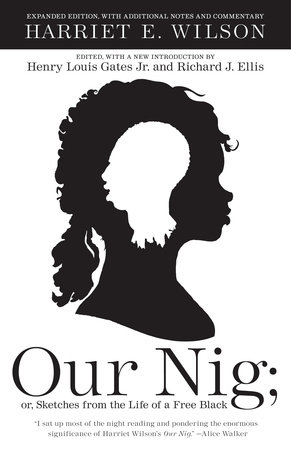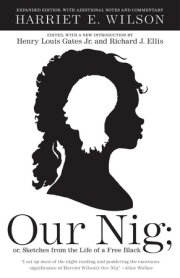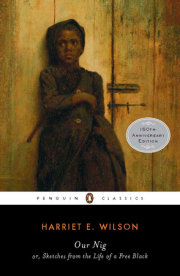Introduction
Henry Louis Gates, Jr., and R. J. Ellis
I can say with much pleasure that when the Regenerator was first applied to my own hair it was very gray, and falling from my head, and my scalp was in a very unhealthy state; but upon a few applications I discovered a decided change, and soon my hair assumed its original color and health of youth.
-Mrs. H. E. Wilson, Nashua, N.H.
Harriet E. Adams Wilson's Our Nig (1859) is the first novel written and published in English by an African American woman writer. The story Wilson tells is profoundly moving and seemingly straightforward. But this straightforwardness is deceptive: the novel, taking as its unusual focus the fate of a Northern mulatta, Alfrado (or Frado) Smith, explores in unique detail the contested position of free blacks in antebellum America, and specifically the plight of female free blacks, at what was a highly problematic time in America's racial history.
Frado is deserted as a young girl by Mag Smith, her white mother, following the death of her African American father, Jim, "a kind- hearted African," and Mag's subsequent marriage to Jim's friend, Seth Shipley. The Shipleys cannot cope financially and decide to move away, resolving to leave Frado behind. They deposit Frado at the home of a white New England farming family, the Bellmonts. There she becomes their farm servant, treated harshly and derogatorily nicknamed "Our Nig." Two members of this family, Mrs. Bellmont and her daughter, Mary, sadistically mistreat Frado. The males of the Bellmont household and a maiden aunt, Aunt Abby, voice their support for her and sometimes even attempt to protect her but fail to assist her in any meaningful way, for lack of will and courage.
The novel depicts Frado's progress in learning to defend herself from this harsh treatment by fighting back with words and actions and finding her voice. After years of mistreatment, Frado completes her period of service and is allowed to leave. Wilson sketchily outlines Frado's subsequent fortunes in two closing chapters, in which she meets a young black man, Samuel, quickly marries him, and has a child. He soon deserts her, after confessing to her that he is passing himself off as a fugitive slave in order to profit from the abolitionist lecture circuit. Left behind in New England, Frado does obtain some financial support, including public charity, but always lives in dire poverty. This destitution and her declining health (precipitated by Mrs. Bellmont's sustained physical abuse) eventually force her to leave her child in foster care as she struggles to survive.
Alongside Frado's story, we learn details of the Bellmont family's own problems, generated most often by Mrs. B.'s meanness. But the novel's plot focuses principally on Frado's sufferings and her uncertain progress toward embracing Christianity. Three pseudonymous testimonials at the end of the book emphasize the Christian context of the tale and urge its authenticity, while an author's preface explains that she is publishing her story to rescue herself and her child from destitution. One of the testimonials further reveals that the author and her child have been reduced to drawing upon public relief. Published in 1859, Our Nig offers, through this simple story, a very rare thing indeed: a sustained representation of the life of an antebellum free black female, born and bred in New England and working as a farm servant. As Alice Walker observed in 1983 in a comment published on the dust jacket of the first Random House edition edited by Henry Louis Gates, Jr., the novel is of "enormous significance" because it represents "heretofore unexamined experience." It is one of the very first full-length books written by an African American who was not a slave; it stands as a hallmark of literary history as the first novel published by an African American woman in the United States; and it subtly combines compelling storytelling with unflinching indictments of Northern anti-black racism.
Harriet Wilson seems to have published Our Nig herself (though likely with some assistance from unknown patrons), which makes its composition highly unusual: very few African American writers at this time could have taken such a step, an extraordinary one for an impoverished person of any race. The book's survival was to prove precarious for more than a hundred years, since, after one apparently very limited print run, it remained almost unnoticed until 1983, when Henry Louis Gates, Jr., established the identity and race of its author, recovered its history, and published the first new edition since 1859. His research revealed definitively that the book was a novel written by an African American female, thereby attracting for the first time concerted attention to Harriet E. Adams Wilson, her text, its place in literary history, and what it contributes to our understanding of the history of racism in antebellum America.
This definitive new edition, a century and a half after Harriet Wilson published the first edition, carefully lays out the ways in which the author's life helps illuminate the themes and concerns of her novel. In particular, for the first time, we examine in detail Wilson's extensive commitment to and engagement with the profession of spiritualism as she struggled to make a living for herself after she published her novel. We then bring these biographical matters to bear on the composition of Our Nig. By tracing in considerable detail just how difficult it was for her to carve out a place within Boston's spiritualist circles following the Civil War, we have established the extent of Harriet Wilson's astonishing achievements over the course of her unusual life.
Opening one of the few extant copies of the 1859 edition of Our Nig is a profoundly moving experience. The book was well produced, albeit with an unprepossessing board binding. Its spine contains the simplest information: the bald, disconcerting title Our Nig (accompanied by a colophon), but inside the title page adds a long and complex subtitle, followed by the obviously pseudonymous author's name. Nothing published before 1859 by any other black author could possibly prepare the reader for the unusual wording:
OUR NIG;
OR,
Sketches from the Life of a Free Black,
IN A TWO-STORY WHITE HOUSE, NORTH.
SHOWING THAT SLAVERY'S SHADOWS FALL EVEN THERE.
BY "OUR NIG."
The wording "Sketches from the Life . . . by 'Our Nig'_" of course reminds us of the subtitles of other narratives by African Americans, such as Frederick Douglass's 1845 slave narrative, which carries a subtitle informing us it was "Written by Himself," or Harriet Jacobs's Incidents in the Life of a Slave Girl, Written by Herself, published just two years after Harriet Wilson's novel appeared. But Our Nig's subtitle also establishes that it is written not by a slave, but by a "Free Black" living in the North. The title page as well as the novel itself undermine all expectations that anything like a conventional slave narrative is on offer. Wilson does not usher in a story about a daring dash to freedom from the South to the North, along a road paved by literacy, as Frederick Douglass famously asserted. Instead Frado remains trapped by the hardships imposed by widespread Northern racism. In the preface the author tells us she is "forced" to write her book as an "experiment which shall aid me in supporting myself and my child" (3). What lies before us indeed turns out to be an experiment; a unified fiction informed by the genres of the sentimental novel, the gothic autobiography, the slave narrative, and realism.
Our Nig's subtitle, by announcing that it is written by a "Free Black," in itself at once establishes the book as unusual, for very few texts had been published before this time by black authors who had not formerly been slaves. Appearing in 1859, Our Nig is predated by only a few works of fiction by black writers, including: Frederick Douglass's novella The Heroic Slave (1853); William Wells Brown's novel Clotel (1853); Frank Webb's The Garies and Their Friends (1857), and Martin R. Delany's Blake; or, The Huts of America (the first part serialized in The Anglo-African Magazine in 1859 and the remainder in the Weekly Anglo-African newspaper between 1861 and 1862). Whereas the theme of most of these works of fiction was slavery, Frank Webb depicted the lives of free African Americans in the North, just as Wilson would two years later. (Curiously enough, another black woman writer, Maria F. dos Reis, published a novel entitled Ursula in Brazil, also in 1859.)
Our Nig's subtitle further surprises when it notes that, though slavery had been abolished in the North, nevertheless "Slavery's Shadows Fall Even There." Very few writers before Wilson had chosen to focus on the way that slavery could blight the lives of free African Americans in the North. The "shadows" of slavery to which Wilson refers consist, on the one hand, of anti-black racism, of which Wilson's novel is a surprisingly bold and unflinching critique. But the subtitle also refers to the shadows cast on all black people's lives by the Fugitive Slave Act. Passed in 1850 at the behest of Southern slaveholders, the act facilitated the recapture of runaway slaves in the North, although slavery had already been abolished there, state by state. The law controversially compelled Northerners, including abolitionists and free blacks, to stand by impotently as African Americans were seized by slave catchers and returned to their "owners" in the South. The act made it illegal to intervene or offer any assistance to a fugitive. It also provided Northern magistrates with a financial incentive to accept that African Americans brought before them by slave catchers were indeed escaped slaves, thus encouraging the capricious seizure of free African Americans. Such kidnappings were not rare. Slavery's long shadows thus fell on all African Americans in the North, including Frado, Harriet Wilson's protagonist. At one point near her book's end she reports that Frado is "watched by kidnappers" and adds that "traps" were "slyly laid by the vicious to ensnare her" (129). Described in the novel as "beautiful" (17), Frado would have been highly desirable prey for lascivious slave owners, since female mixed-race slaves generally commanded the highest prices in Southern slave auctions.
More important than the risk of kidnap under the Fugitive Slave Act, "slavery's shadows" also alludes to the prevalence of racism in the Northern free states, such as New Hampshire. Especially during the three decades leading up to the Civil War, Southerners, forced on the defensive by abolitionists, sought to legitimate slavery's continuation through a racist argument proposing that African Americans' color, cranium shape, facial features, and hair texture proved that they were not fully human, or instead were a different or distinct species from human beings of European descent, represented as God's chosen creation. Proslavery propaganda represented people of African descent as vastly less intelligent than white people, more prone to laziness and violence, and more likely to surrender to base impulses and appetites, especially sexual ones. The seeds of "scientific" racism sown in this way (the science was, of course, pseudo-scientific, based on prejudice and superstition, entirely unfounded in reason or fact, and drawn up to justify a profoundly exploitative economic relationship) ensured that slavery's shadows would indeed fall across the whole of the United States long after its abolition and well into the twentieth century. Even those who opposed slavery were sometimes swayed, shockingly enough, by arguments for the innate inferiority of persons of African descent. (Harriet Beecher Stowe's depiction of Miss Ophelia's reluctance to touch Topsy in Uncle Tom's Cabin provides one famous example among countless others.)
By the time Our Nig was published, just two years before the Civil War began, the abolition movement had been gaining momentum throughout the North for several decades and had spread to popular culture. For example, the Hutchinson Family Singers, a New Hampshire troupe closely connected to Wilson's birthplace, Milford, toured throughout New England winning widespread acclaim for the songs they performed, portraying their state as freedom loving and opposed to slavery. Yet, even as the antislavery cause grew, America's leading white abolitionist, William Lloyd Garrison, was forced to expend time and energy trying to excise individual racism from among his followers. The New Hampshire abolitionist Nathaniel Rogers even came to believe that "laws could never eradicate prejudice and racial domination" and that a more fundamental, more perfect revolution than America's War of Independence was needed. What Rogers had seen in Canaan, New Hampshire, in 1835, where an attempt to desegregate Noyes Academy was greeted with violent resistance by the local community, no doubt informed his opinion about the deep-rooted nature of racial prejudice in American society and what it might take to eradicate it, both on an institutional and a behavioral level.
Our Nig therefore has good reason to allude to racism as "slavery's shadows" in the North, but it also establishes the novel's central theme: exposing the many ways in which Frado experiences anti-black racism at the hands of Northern whites and the ways in which race and class were inextricably intertwined in antebellum America, North and South. Our Nig takes up this theme in an unusual way, since its accent falls on abuse by white females (adapting Frederick Douglass's dramatic observation in his 1845 slave narrative that slavery turned many female slave owners into racists and sadists, even those initially reared in the North). Among the Bellmonts, during Frado's period of indenture, two of its females, Mary and Mrs. Bellmont, are depicted as the physically cruel ones. After she leaves them, another Northern white woman, Mrs. Hoggs, ignoring how feeble Frado has become after her years of mistreatment, reports her as a malingerer to the town's authorities. Yet, though some of the other Bellmonts have abolitionist sympathies, they do nothing to put an end to Frado's sufferings, which continue until she leaves their house. However much James Bellmont tells her that his "mother's views were by no means general" and assures her that she is not "friendless, and utterly despised" but instead "might hope for better things in the future" (76), he does nothing to intervene, and soon she is once again being "whipped with a rawhide" (77). James's brother, Jack, provides more sympathy, but no protection either.
Indeed, the lack of effective counters to racism in the "free" North is another key theme of the book. In chapter 1, the narrator ruminates ironically on the supposedly "degraded" condition of Mag Smith, Frado's white mother, because of her decision to marry an African American: "You can philosophize, gentle reader, upon the impropriety of such unions, and preach dozens of sermons on the evils of amalgamation. . . . Poor Mag. She had sundered another bond which held her to her fellows. She had descended another step down the ladder of infamy" (13). Mag Smith's decision to marry a black man leads her inexorably toward a state of social death in white society, precisely because of widespread Northern prejudices against what was then, objectionably, called "amalgamation." Nevertheless, Wilson refrains from representing Frado's parents' liaison sentimentally. Instead, she reveals that the motivations for this marriage are, at best, deeply fraught and problematic, especially those of Frado's father, Jim, whose unrelenting desire to have a white lover she represents as perverse. Even if Jim's motivations are dubious, however, by sarcastically introducing the idea that "amalgamation," the nineteenth- century's term of choice for interracial sexual relations between whites and blacks, was "evil," Wilson challenges her readers to push back against a core argument of Southern apologists for slavery.
Copyright © 2011 by Harriet E. Wilson. All rights reserved. No part of this excerpt may be reproduced or reprinted without permission in writing from the publisher.









